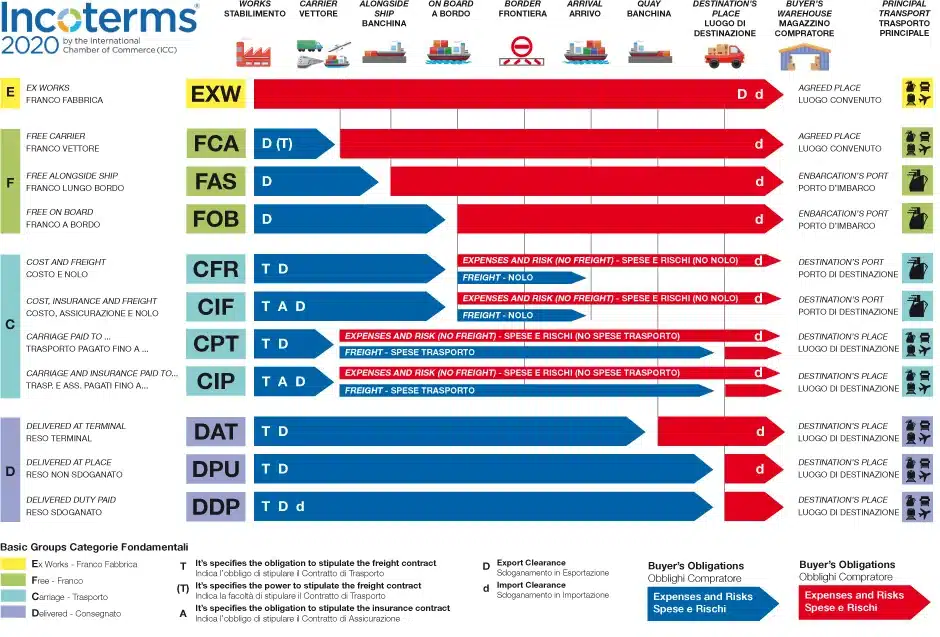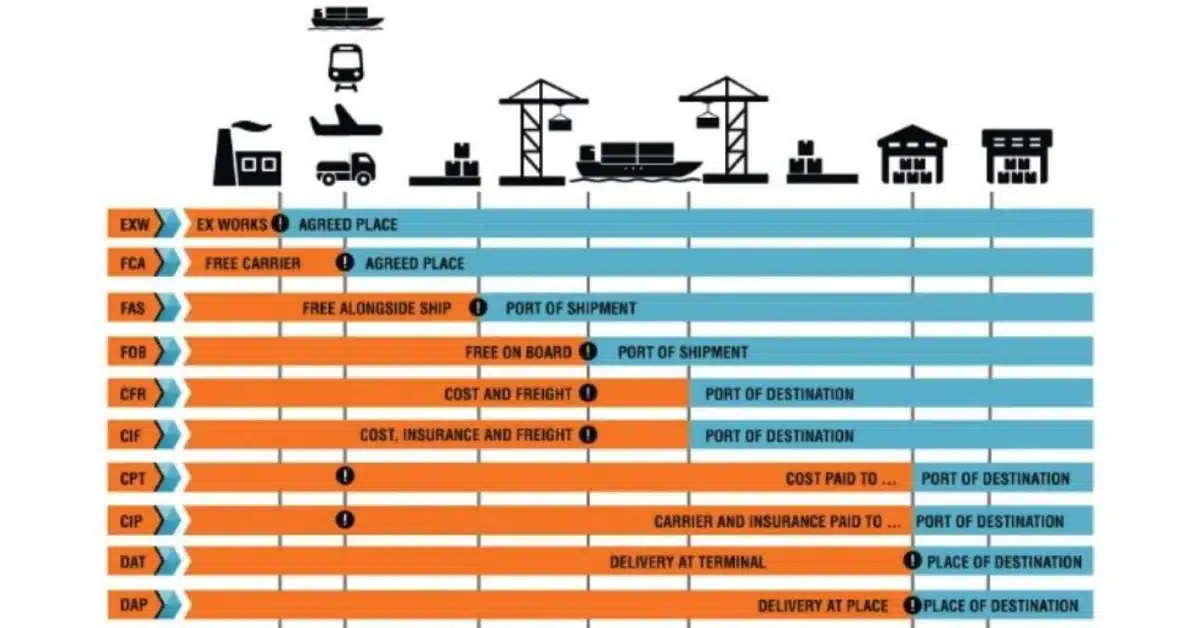Complete Guide to Maritime Freight Terms and Incoterms® 2020
Table of Contents
I. Introduction
International trade relies heavily on a set of standardized rules and terms to ensure clear and fair transactions between buyers and sellers. One of the most critical aspects of this process is maritime freight and the use of Incoterms® 2020, which govern the responsibilities and costs associated with the international transportation of goods.
Maritime freight doesn’t just cover the transport of goods from one port to another; it also includes additional costs such as loading, unloading, and other port operations. Incoterms® 2020 defines the conditions under which this transportation takes place, specifying the responsibilities of the sellers and buyers regarding costs, risks, and control of goods during transit.
This article will provide a comprehensive guide on Incoterms® 2020 and the different maritime freight contracting terms. We will explore how each modality affects logistics operations and how to choose the right Incoterm to optimize both costs and operational efficiency in international trade.
II. Maritime Freight Contracting Terms
A. Basic Freight
Basic freight is the simplest form of maritime freight contracting, as it only covers transportation between ports. It does not include additional services such as loading, unloading, stowing, or any pre/post-hook operations. This type of freight is ideal for companies managing their own logistical operations at both the origin and destination ports or when no additional services are required.
- Costs included: Main maritime transport between ports.
- Costs excluded: Loading, unloading, stowing, de-stowing, insurance, and other logistical services.
Relevant Statistics: Around 30% of maritime freight contracts utilize basic freight due to its simplicity and controlled costs.
Practical Example: An exporter in Spain uses basic freight to ship goods to Mexico, taking care of the loading and unloading at the port by themselves.
B. Liner Terms
Liner terms include loading, stowing, de-stowing, and unloading, but exclude pre/post-hook operations. This is a more comprehensive modality than basic freight, covering much of the port operations, yet the buyer remains responsible for aspects like transportation from the port of destination to their warehouse.
- Services included: Loading, stowing, de-stowing, unloading.
- Services excluded: Transport to/from the warehouse, customs, and other costs.
Relevant Statistics: About 45% of maritime freight contracts use liner terms in sectors like consumer goods and machinery trade.
Practical Example: A machinery import company uses liner terms to receive products but covers only the transport from the port of destination to their warehouse.
C. F.I.O.S. (Free In and Out Stowed)
The F.I.O.S. (Free In and Out Stowed) term means the seller covers all costs related to transportation until the departure port, but excludes costs for loading, unloading, and stowing. This contract is commonly used in shipping large volumes or heavy cargo, where loading and unloading operations are not covered by the freight cost.
- Costs included: Maritime transport up to the departure port.
- Costs excluded: Loading, unloading, and stowing.
Relevant Statistics: F.I.O.S. is increasingly popular for bulk cargo and heavy goods shipping, especially in industries like mining and agriculture.
Practical Example: A coal exporter in South Africa uses F.I.O.S. to ship cargo to China, with the buyer covering stowing and unloading at the destination port.
D. All-In Freight
All-in freight is the most comprehensive form of contracting, as it covers all operations involved in transporting goods, including transport to the warehouse. This is an ideal solution for companies that prefer an all-inclusive, predictable cost structure.
- Services included: Maritime transport, loading, unloading, stowing, de-stowing, and land transport to the warehouse.
- Services excluded: Generally, no additional costs.
Relevant Statistics: 25% of large companies opt for all-in freight due to its predictability and logistics efficiency.
Practical Example: An electronics distribution company in the U.S. uses all-in freight to ship products from Asia, ensuring all logistics are managed from the port of origin to their warehouse.

III. Breakdown of Incoterms® 2020
A. Group E: Ex Works (EXW)
In the Group E of Incoterms, EXW (Ex Works) is the most commonly used Incoterm when the seller makes the goods available at their premises. From there, the buyer assumes all costs and risks associated with transporting the goods.
- Seller’s responsibilities: Make goods available at their premises.
- Buyer’s responsibilities: Assume all costs and risks from the seller’s premises.
Relevant Statistics: EXW is ideal for exporters who wish to minimize control over the logistics process.
Practical Example: A seller in Brazil uses EXW to make goods available for a buyer in Germany, with the buyer assuming all risks from the moment the goods are available at the seller’s premises.
B. Group F: Delivery to Carrier
Incoterms in the Group F (FCA, FAS, FOB) involve the seller delivering the goods to a carrier designated by the buyer.
- Seller’s responsibilities: Deliver the goods to the buyer-designated carrier.
- Buyer’s responsibilities: Assume the cost and risk of the main transport.
Relevant Statistics: FOB (Free On Board) is the most popular Incoterm in maritime shipping, especially in international trade.
Practical Example: An importer in China uses FOB to receive goods from a supplier in Brazil, assuming risk and cost from the moment the goods are loaded onto the ship.
C. Group C: Paid Freight by Seller
In Group C, the seller pays for the main transport, but the risk is transferred to the buyer at a specific point.
- Seller’s responsibilities: Pay for the main transport.
- Buyer’s responsibilities: Assume the risk at the point of delivery.
Relevant Statistics: CIF is widely used in international trade for products like oil and chemicals.
Practical Example: A Spanish exporter of olive oil uses CIF to ship to the U.S., covering the freight and insurance until the port of destination.
D. Group D: Full Delivery by Seller
Incoterms in the Group D (DAP, DPU, DDP) involve the seller assuming all costs and risks until the goods arrive at the final destination.
- Seller’s responsibilities: Assume all costs and risks until the agreed destination.
- Buyer’s responsibilities: Pay customs and other import charges.
Relevant Statistics: DDP is commonly used in transactions where the seller wishes to have complete control over the delivery process.
Practical Example: A heavy machinery exporter in Germany uses DDP to deliver machinery to a buyer in Australia, covering all transportation costs and risks.
IV. Comparative Table of Responsibilities in Incoterms® 2020
| Incoterm | Risk Transfer | Main Transport | Insurance | Customs |
|---|---|---|---|---|
| EXW | Seller’s premises | Buyer | Optional | Buyer |
| FOB | On board the ship | Buyer | Optional | Seller (Export) |
| CIF | On board the ship | Seller | Seller | Seller (Export) |
| DDP | Final destination | Seller | Optional | Seller (Both) |
V. Relevant Data and Context
Origin of Incoterms:
Incoterms are standardized by the International Chamber of Commerce (ICC) and are updated every 10 years. The most recent version, Incoterms® 2020, was launched to adapt to changes in global trade.
Global Use:
More than 80% of international trade uses Incoterms to clearly define the responsibilities of the parties involved and avoid legal disputes.
Practical Example:
An Argentine exporter selling CIF Rotterdam: The seller pays for freight and insurance to Rotterdam, but the buyer assumes the risk once the goods are on board the ship. If the contract is F.I.O.S., the buyer covers the unloading costs at the destination.
VI. Recommendations for Applying Incoterms® 2020
- For Exporters: Use CIP or DDP to have more control over logistics and costs. These options allow the seller to ensure the buyer receives the goods with no additional surprises.
- For Importers: FCA or EXW are ideal to reduce responsibilities, but they require the importer to manage the main transport logistics.
- Verification:
- Always ensure the Incoterms version (2020 vs. 2010).
- Define if the transport is multimodal (e.g., CPT) or just maritime (e.g., FOB).
VII. Conclusion
Incoterms® 2020 and freight contracting terms are fundamental to international trade. Understanding the responsibilities and costs associated with each option helps prevent unexpected costs and legal disputes. Always consult the most current version of Incoterms and select the freight modality that best suits your logistical and commercial needs.





